
Schinia, commonly called flower moths, is a large genus of moths belonging to the family Noctuidae. The genus has a Holarctic distribution with the vast majority of species being found in North America, many with a very restricted range and larval food plant.

Phragmataecia is a genus of moths belonging to the family Cossidae. Members of this genus are found throughout the world apart from North America.

Lithophane is a genus of moths of the family Noctuidae. They spend the winter as adults. Some species are capable of feeding on other caterpillars or on sawfly larvae, which is rather uncommon among Lepidoptera.
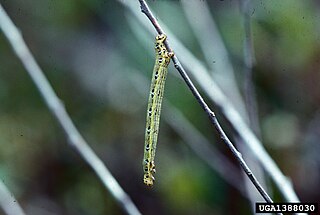
Cingilia is a monotypic moth genus in the family Geometridae erected by Francis Walker in 1862. Its only species, Cingilia catenaria, the chain-dotted geometer, chain dot geometer, chainspotted geometer or chain-spotted geometer, was first described by Dru Drury in 1773. It is found in North America from Nova Scotia south to Maryland and west to Kansas and Alberta.
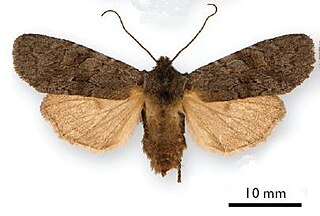
Lithophane adipel is a moth of the family Noctuidae first described by Foster Hendrickson Benjamin in 1936. The wingspan is about 42 mm.

Euxoa medialis, the median-banded dart, is a moth of the family Noctuidae. The species was first described by Smith in 1888. It is found in North America from southern Manitoba and central Wisconsin, west to southwest Alberta and California; north to southern Alberta and south to south-central Mexico.

Acronicta sperata, the hopeful dagger moth, is a moth of the family Noctuidae. The species was first described by Augustus Radcliffe Grote in 1873. It is found in North America from New Brunswick west to the Alberta foothills, south to the District of Columbia, Missouri and in the mountains to Colorado.

Acronicta hasta, the forked dagger moth, speared dagger moth, cherry dagger moth or dart dagger moth, is a moth of the family Noctuidae. The species was first described by Achille Guenée in 1852. It is found in North America in the eastern deciduous woodlands, ranging west across southern Saskatchewan and Alberta into central southern British Columbia, south to Tennessee, Wisconsin and Kansas.
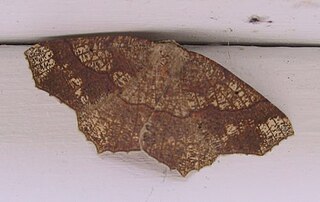
Besma quercivoraria, the oak besma, is a moth of the family Geometridae. The species was first described by Achille Guenée in 1857. It is found across southern Canada and all of the United States except California.

Lithophane ornitopus, the grey shoulder-knot, is a moth of the family Noctuidae. The species was first described by Johann Siegfried Hufnagel in 1766 and is found in most of the Palearctic realm from Ireland east to Siberia.
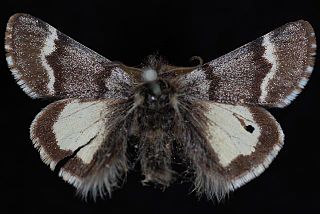
Leucobrephos brephoides, the scarce infant moth, is a moth of the family Geometridae. The species was first described by Francis Walker in 1857. It is found in North America from Yukon to Labrador and south to New York and southern Alberta and British Columbia. The habitat consists of open mixed wood forests of the boreal and mountain region.

Synchlora aerata, the wavy-lined emerald moth or camouflaged looper, is a species of moth of the family Geometridae. The species was described by Johan Christian Fabricius in 1798. It is found in most of North America.
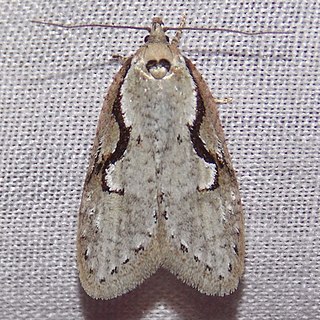
Semioscopis packardella, also called Packard's concealer moth or Packard's flatbody moth, is a species of moth of the family Depressariidae. It was described by James Brackenridge Clemens in 1863. It is found in North America in central Alberta, southern Quebec, Manitoba, California, Idaho and Oregon and from New Jersey to Ohio.
Scopula innominata is a moth of the family Geometridae. It is found in Puerto Rico.
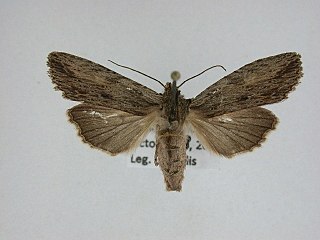
Lithophane signosa, the signate pinion or sycamore pinion moth, is a species of moth in the family Noctuidae. The species was described by Francis Walker in 1857. It is found in North America.

Lithophane grotei, commonly known as Grote's pinion or Grote's sallow, is a species of moth in the family Noctuidae. It was first described by Riley in 1882 and it is found in North America.

Lithophane petulca, the wanton pinion, is a species of cutworm or dart moth in the family Noctuidae. It is found in North America.

Lithophane itata is a species of cutworm or dart moth in the family Noctuidae. It is found in North America.

Lithophane georgii, known generally as George's pinion moth, is a species of cutworm or dart moth in the family Noctuidae. Other common names include the large grey pinion and green fruitworm. It is found in North America.

















